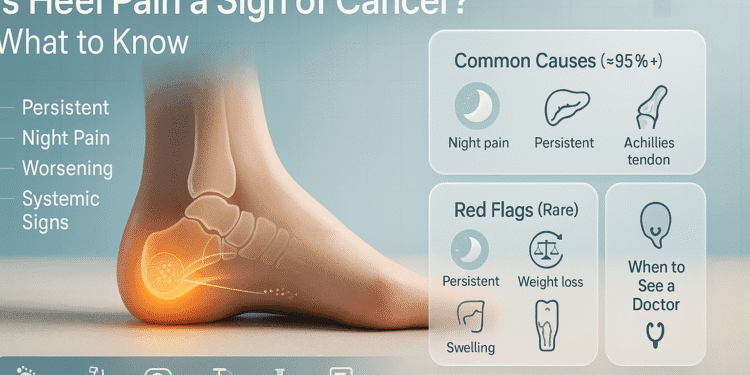Is Heel Pain a Sign of Cancer? Understanding the Connection
Have you ever experienced persistent heel pain that just won’t go away? While most people immediately think of common conditions like plantar fasciitis, a nagging question might cross your mind: could this be something more serious, like cancer?
Let’s dive deep into this concern and separate fact from fiction. Understanding the relationship between heel pain and cancer can help you make informed decisions about your health and know when it’s time to seek medical attention.
Understanding Heel Pain Basics
What Causes Heel Pain?
Heel pain is incredibly common, affecting millions of people worldwide. Your heel bears the brunt of your body weight with every step you take, making it susceptible to various conditions. Think of your heel as the foundation of a building – when there’s a problem with the foundation, the entire structure feels the impact.
The heel consists of the calcaneus bone, surrounded by muscles, tendons, ligaments, and a thick layer of fat that acts as a natural shock absorber. When any of these components become damaged or inflamed, pain can result.
Most heel pain stems from mechanical issues rather than serious underlying diseases. However, understanding all possible causes, including rare ones like cancer, helps you stay informed about your health.
Common Types of Heel Pain
Heel pain typically manifests in two primary locations: the bottom of the heel (plantar heel pain) and the back of the heel (posterior heel pain). The location, timing, and characteristics of your pain can provide valuable clues about its underlying cause.
Plantar heel pain often feels sharp and stabbing, particularly during your first steps in the morning. Posterior heel pain, on the other hand, might feel more like a dull ache that worsens with activity.
Cancer and Heel Pain: The Reality Check
Can Cancer Cause Heel Pain?
Yes, cancer can cause heel pain, but it’s extremely rare. When we talk about cancer-related heel pain, we’re typically discussing either primary bone cancer that develops in the heel bone itself or metastatic cancer that spreads to the heel from another location in the body.
Here’s the reassuring news: the vast majority of heel pain cases – we’re talking about 95% or more – have nothing to do with cancer. Your heel pain is far more likely to be caused by common conditions like plantar fasciitis, heel spurs, or Achilles tendonitis.
However, this doesn’t mean you should completely dismiss the possibility, especially if your heel pain has unusual characteristics or doesn’t respond to typical treatments.
Types of Cancer That May Affect the Heel
When cancer does affect the heel, it usually falls into two categories: primary bone cancers and metastatic cancers. Primary bone cancers originate in the bone tissue itself, while metastatic cancers spread to the bone from other parts of the body.
Primary bone cancers in the heel are exceptionally rare. The heel bone (calcaneus) is not a common site for primary bone tumors, which tend to favor the long bones of the arms and legs, particularly around the knee area.
Metastatic cancer is more common than primary bone cancer in the heel, but it’s still relatively rare. Cancers that commonly spread to bones include breast, lung, prostate, kidney, and thyroid cancers.
Primary Bone Cancers in the Heel
Osteosarcoma
Osteosarcoma is the most common type of primary bone cancer, but it rarely affects the heel. This aggressive cancer typically develops in the long bones and primarily affects children, teenagers, and young adults.
When osteosarcoma does occur in the heel, it can cause persistent, deep bone pain that gradually worsens over time. Unlike typical heel pain that improves with rest, cancer-related pain often persists or even worsens at night.
The pain from osteosarcoma is usually described as deep, aching, and constant. It doesn’t typically improve with rest, ice, or over-the-counter pain medications – unlike most common causes of heel pain.
Chondrosarcoma
Chondrosarcoma is another type of bone cancer that can, though rarely, affect the heel. This cancer develops in cartilage cells and tends to grow more slowly than osteosarcoma.
Chondrosarcoma typically affects adults, with most cases occurring in people over 40. The pain from chondrosarcoma might be more subtle initially, gradually increasing over months or years.
Symptoms and Warning Signs
Both types of primary bone cancer share certain warning signs that distinguish them from common heel pain causes. These include persistent pain that doesn’t improve with rest, night pain that interrupts sleep, and progressive worsening over time.
You might also notice swelling around the heel area, although this can be subtle initially. The skin over the affected area might feel warm to the touch, and you may experience unexplained fatigue or weight loss.
Metastatic Cancer and Heel Pain
How Cancer Spreads to Bones
When cancer spreads to bones, it’s called bone metastasis. Cancer cells break away from the original tumor, travel through the bloodstream or lymphatic system, and establish new tumors in bone tissue.
Bone metastasis can cause pain through several mechanisms. The cancer cells can directly damage the bone, disrupt normal bone remodeling processes, or cause pathological fractures.
The pain from bone metastasis is often described as deep, aching, and constant. It may worsen at night and doesn’t typically improve with rest or position changes.
Common Primary Cancers That Metastasize to Bones
Certain cancers have a higher tendency to spread to bones. Breast cancer, for example, spreads to bones in about 70% of advanced cases. Prostate cancer also commonly metastasizes to bones, affecting up to 90% of men with advanced disease.
Lung cancer, kidney cancer, and thyroid cancer also frequently spread to bones. However, it’s important to note that these cancers more commonly affect the spine, pelvis, and ribs rather than the heel.
When cancer does spread to the heel, it’s usually part of widespread bone metastasis rather than an isolated occurrence.
Warning Signs That Require Immediate Attention
Red Flag Symptoms
Certain characteristics of heel pain should prompt immediate medical evaluation. These “red flag” symptoms include pain that’s severe and persistent, doesn’t improve with rest, or worsens progressively over time.
Night pain is particularly concerning. While common heel conditions like plantar fasciitis typically feel better at night when you’re not putting weight on your feet, cancer-related bone pain often intensifies during rest periods.
Unexplained weight loss, fatigue, or fever accompanying heel pain could indicate a systemic condition like cancer. These symptoms, combined with persistent heel pain, warrant prompt medical evaluation.
When Heel Pain Becomes Concerning
Your heel pain becomes concerning when it deviates from typical patterns. If you’ve had heel pain for several weeks without improvement despite appropriate treatment, it’s time to dig deeper.
Pain that’s severe enough to significantly limit your daily activities or that requires prescription pain medication should be evaluated thoroughly. Similarly, if you notice any visible changes to your heel, such as swelling, discoloration, or skin changes, seek medical attention.
Have you noticed that your heel pain doesn’t follow typical patterns? For instance, if it doesn’t hurt more in the morning or after periods of inactivity – which is characteristic of most common heel conditions – this could be a clue that something else is going on.
Common Non-Cancerous Causes of Heel Pain
Plantar Fasciitis
Let’s put things in perspective. Plantar fasciitis accounts for about 80% of all heel pain cases. This condition involves inflammation of the thick band of tissue (plantar fascia) that runs across the bottom of your foot, connecting your heel bone to your toes.
The classic symptom of plantar fasciitis is sharp heel pain that’s worst with your first steps in the morning or after sitting for extended periods. The pain typically improves as you walk around and your foot “warms up.”
Unlike cancer-related pain, plantar fasciitis pain usually responds well to rest, stretching, proper footwear, and over-the-counter anti-inflammatory medications.
Heel Spurs
Heel spurs are bony growths that develop on the heel bone, often in conjunction with plantar fasciitis. Contrary to popular belief, heel spurs themselves rarely cause pain – it’s usually the associated soft tissue inflammation that hurts.
The pain from heel spurs typically mimics plantar fasciitis pain, occurring primarily on the bottom of the heel and feeling worst in the morning or after periods of rest.
Achilles Tendonitis
Achilles tendonitis causes pain at the back of the heel, where the Achilles tendon attaches to the heel bone. This condition is common in runners and people who suddenly increase their physical activity level.
The pain from Achilles tendonitis typically worsens with activity and improves with rest – the opposite pattern you’d expect from cancer-related bone pain.
Other Musculoskeletal Conditions
Several other conditions can cause heel pain, including bursitis, stress fractures, and nerve entrapment syndromes. Each has characteristic patterns that help differentiate them from more serious conditions.
Stress fractures, for example, cause pain that worsens with weight-bearing activity and improves with rest. Nerve entrapment might cause burning or tingling sensations along with pain.
Diagnostic Approaches
Physical Examination
When you see a doctor for heel pain, they’ll start with a thorough physical examination. They’ll assess your pain patterns, examine your foot structure, and test your range of motion and strength.
Your doctor will also look for signs that might suggest something more serious than common heel conditions. These might include visible swelling, skin changes, or lymph node enlargement.
The physical examination can often distinguish between common heel conditions and more serious problems. For instance, plantar fasciitis pain typically has very specific trigger points, while cancer-related pain might be more diffuse.
Imaging Tests
If your doctor suspects something more serious than common heel conditions, they may order imaging tests. X-rays are usually the first step, as they can reveal bone abnormalities, fractures, or signs of bone destruction.
However, early bone cancers might not show up on regular X-rays. More advanced imaging tests like MRI or CT scans might be necessary if there’s strong suspicion of cancer or if your symptoms don’t match common conditions.
Bone scans can also be helpful in detecting cancer that has spread to multiple bones throughout the body.
When Biopsy Is Necessary
If imaging tests reveal suspicious lesions, a biopsy might be necessary to determine whether cancer is present. During a biopsy, a small sample of tissue is removed and examined under a microscope.
Biopsies are invasive procedures and are only performed when there’s significant concern about cancer based on symptoms and imaging findings.
Risk Factors for Heel Cancer
Age and Demographics
Primary bone cancers like osteosarcoma typically affect younger people, with peak incidence in teenagers and young adults. Chondrosarcoma, on the other hand, more commonly affects adults over 40.
Metastatic cancer to the heel is more likely in older adults who have a history of cancer elsewhere in the body. The risk increases with age as the incidence of cancer in general increases.
Previous Cancer History
If you’ve had cancer before, especially cancers known to spread to bones, you might be at higher risk for developing bone metastases. However, this doesn’t mean that every ache and pain is related to cancer.
Most cancer survivors who develop heel pain have common conditions just like everyone else. However, it’s reasonable to have a lower threshold for seeking medical evaluation if you have a cancer history.
Treatment Options
Cancer Treatment Approaches
If cancer is diagnosed as the cause of your heel pain, treatment will depend on whether it’s a primary bone cancer or metastatic disease. Treatment might include surgery, chemotherapy, radiation therapy, or a combination of these approaches.
For primary bone cancers, surgery to remove the tumor is often the primary treatment, sometimes followed by chemotherapy or radiation therapy. In some cases, limb-sparing surgery can preserve function while removing the cancer.
For metastatic cancer, treatment focuses on controlling the cancer throughout the body while managing pain and preserving function.
Pain Management Strategies
Cancer-related bone pain often requires aggressive pain management. This might include strong pain medications, radiation therapy to shrink tumors, or medications that strengthen bones and reduce fracture risk.
The goal is to maintain quality of life while treating the underlying cancer. Pain management is an integral part of cancer care, not just an afterthought.
When to See a Doctor
Immediate Medical Attention Signs
Certain symptoms accompanying heel pain require immediate medical attention. These include severe pain that suddenly worsens, signs of infection like fever or red streaking, or inability to bear weight on the affected foot.
If you experience sudden, severe heel pain following an injury, this could indicate a fracture that needs immediate treatment.
Regular Check-up Recommendations
For most heel pain, it’s reasonable to try conservative treatments for a few weeks before seeking medical attention. However, if your pain persists beyond 2-3 weeks despite appropriate self-care, it’s time to see a healthcare provider.
If you have risk factors for cancer or if your heel pain has concerning characteristics, don’t wait – seek medical evaluation promptly.
Conclusion
While cancer can cause heel pain, it’s extremely rare. The overwhelming majority of heel pain cases result from common, benign conditions like plantar fasciitis, heel spurs, or Achilles tendonitis. These conditions, while painful and sometimes persistent, are not life-threatening and usually respond well to conservative treatment.
However, it’s important to be aware of warning signs that might indicate something more serious. Persistent pain that worsens over time, night pain that disrupts sleep, and pain that doesn’t respond to typical treatments should prompt medical evaluation. Remember, early detection and treatment of any serious condition, including cancer, leads to better outcomes.
The key is finding the right balance between being appropriately concerned about your health without becoming unnecessarily anxious about every ache and pain. When in doubt, consult with a healthcare professional who can properly evaluate your symptoms and provide appropriate guidance.
Your heel pain is most likely nothing to worry about, but staying informed and knowing when to seek help ensures you’ll receive proper care if needed. Don’t let fear of a rare possibility prevent you from addressing a condition that’s probably very treatable.
Frequently Asked Questions
1. How can I tell if my heel pain is from cancer or a common condition?
Cancer-related heel pain typically has distinct characteristics: it’s persistent and doesn’t improve with rest, often worsens at night, progressively gets worse over time, and may be accompanied by systemic symptoms like unexplained weight loss or fatigue. Common heel pain conditions like plantar fasciitis usually hurt most in the morning, improve with movement, and respond to conservative treatments like rest and stretching.
2. What percentage of heel pain cases are actually caused by cancer?
Cancer causes less than 1% of all heel pain cases. The vast majority (over 95%) of heel pain is caused by benign conditions such as plantar fasciitis, heel spurs, Achilles tendonitis, or other musculoskeletal problems. Primary bone cancer in the heel is extremely rare, and even metastatic cancer to the heel is uncommon.
3. Should I be worried about heel pain if I have a history of cancer?
While having a previous cancer diagnosis does slightly increase your awareness level, most heel pain in cancer survivors is still due to common conditions. However, it’s reasonable to have a lower threshold for seeking medical evaluation. If your heel pain has concerning characteristics or doesn’t improve with typical treatments, consult your oncologist or primary care physician for proper evaluation.
4. What tests might my doctor order if they suspect cancer-related heel pain?
Your doctor will likely start with X-rays to look for bone abnormalities. If concerns persist, they may order more advanced imaging like MRI or CT scans, which can detect early bone changes that don’t show up on X-rays. In some cases, a bone scan might be ordered to check for cancer spread throughout the skeleton. A biopsy would only be considered if imaging shows suspicious findings.
5. How long should I wait before seeing a doctor for persistent heel pain?
For typical heel pain, it’s reasonable to try conservative treatments (rest, ice, proper footwear, over-the-counter pain relievers) for 2-3 weeks. However, seek immediate medical attention if you experience severe pain, inability to bear weight, signs of infection, or if you have concerning symptoms like night pain, progressive worsening, or unexplained systemic symptoms. If you have a history of cancer, consider seeking evaluation sooner rather than later.
Please don’t forget to leave a review.









